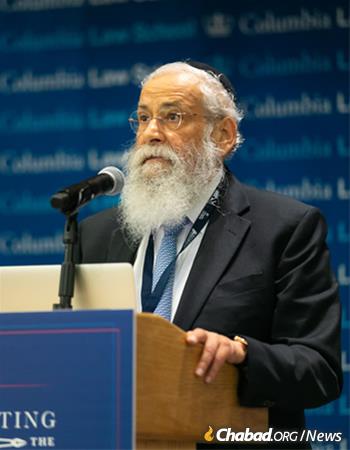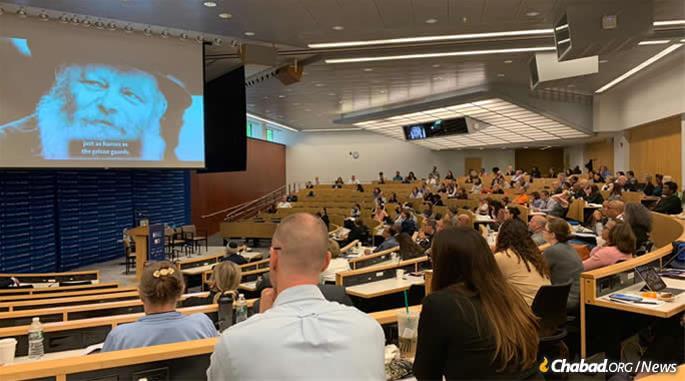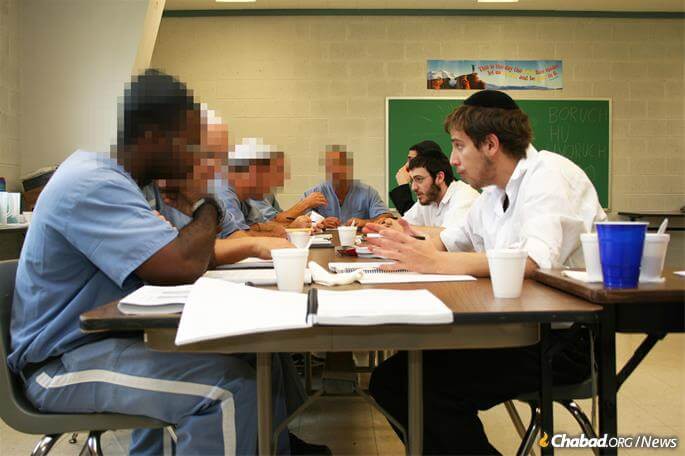Original Article Published on The Chabad.ORG
Tell a friend you are going to federal prison and responses vary from surprise, to sarcastic comments, to questions about why a person would spend precious volunteer time visiting someone who had committed a crime. When I was asked to take part in a new visitation program as a reporter, my own first reaction to the assignment was one of nervousness and even embarrassment. What could I possibly have in common with these guys, even if we were both Jewish? What would we talk about? How would I explain my participation in this program to my friends and family members? Why would I go through an application and screening process just to visit people who had done something bad?
I spoke to a few friends who, much to my surprise, shared with me that each of their communities had several members who had spent time in prison. I began to think about those inmates’ families and what it must be like to have a family member in prison. I wondered what it’s like being Jewish in prison, and what the process of re-entering the Jewish community after release is like.
I’d have to venture inside a facility to find out.
A few months later, with the help and guidance of the Chabad-Lubavitch affiliated Aleph Institute—the leading Jewish organization caring for the incarcerated and their families—I found myself passing through a metal detector and having my hand stamped at the Metropolitan Correctional Center (MCC) in New York, not far from City Hall. A federal facility known for its strict security, MCC is a 12-story concrete fortress in the heart of Manhattan, a place The New York Times quotes an inmate describing as “less hospitable than Guantanamo Bay”—he would know, he’d been in both. MCC is adjacent to the courthouse where I’ve gone for jury duty, but I’d never even known of its existence. Stripped of my phone, keys and wallet, and with only my reporter’s notebook and pen in hand, an officer led me through a series of claustrophobic passageways, eventually to the visitation floor.
In the small, triangular-shaped room where I was told to wait for the Jewish inmates I’d be meeting one at a time, I noticed a would-be inspirational poster on the wall. “Make it happen,” it cheerily read. “There is no challenge too great for those who have the will and heart to make it happen.”
It dawned on me that though geographically close to my own home, I was in an alternate universe.
Visitation Opens Up
The Aleph Institute was founded in 1981 by Rabbi Sholom Ber Lipskar at the express direction of the Rebbe, Rabbi Menachem M. Schneerson, of righteous memory, who was an early and passionate proponent of criminal justice reform. With the goal of reaching out to Jews in limited environments, Aleph has a division dedicated to the incarcerated and a separate one working with the military. It has been a pioneer in both fields.
The guiding principle behind Aleph’s prisoner initiatives, following the Rebbe’s leadership, is that someone who has committed a criminal act is still dear to G‑d and created in His image, with religious responsibilities, the ability to improve, and human emotional needs. Above all, each person has a unique role to play in the world, and the goal must be to assist them in reintegrating into society, where they can resume their individual missions.
“When a person finds himself in a situation of ‘after the sunset,’” the Rebbe wrote in a November 1977 Chanukah letter addressed to prisoners, “when the light of day has given way to gloom and darkness—as was the case in those ancient days under the oppressive Greek rule—one must not despair, G‑d forbid, but on the contrary, it is necessary to fortify oneself with complete trust in G‑d, the Essence of Goodness, and take heart in the firm belief that the darkness is only temporary, and it will soon be superseded by a bright light, which will be seen and felt all the more strongly through the supremacy of light over darkness, and by the intensity of the contrast.”
Despair and despondency is part and parcel of prison life, a feeling of being alone in a harsh, dark world. That’s why Aleph’s motto is: “No one alone, no one forgotten.”
And by feeling “not forgotten,” the chances of making a smooth post-prison transition improves drastically. Of the nearly 2.2 million people incarcerated in the United States today, nearly 75 percent will return to prison within five years of release. As reform advocates continue to work on various programs across the system to lower the recidivism rate—including pre-sentencing diversion, drug rehabilitation and, crucially, educational efforts—one aspect that has continuously borne results are visitation programs. Prisoners who maintain connections with the world outside, members of their families and communities, have a far better chance of landing on their feet once they re-enter society.
Aleph has facilitated prison visits by Chabad rabbis and rabbinical students for decades, but as I learned from Aleph Visitation Circle coordinator Binah Banayan, the process is now opening up. In fact, the Aleph Visitation Circle recently became the first organized volunteer effort in the Jewish community to involve “regular people” outside the rabbinate in one on one prisoner visitation.
“The visitation program was started with the idea in mind that there are a lot of inmates that do not get any visits from their friends or family,” explains Rabbi Dovid Raigorodsky, also an Aleph Visitation Circle coordinator. “This can leave them feeling very lonely, almost like they don’t matter.”
Aleph contacted the Bureau of Prisons (BOP) to begin the work of setting up a one-on-one volunteer visitation program, and BOP eventually granted permission. Since September of 2018 the program has enlisted 65 active volunteers who have visited 20 different federal institutions nationwide, making over 250 visits to date. Another 30 volunteers are currently pending approval by the BOP.
The process of becoming a volunteer is fairly straight-forward. When I decided to make the plunge, I completed the online application form, provided references, and a few weeks later was accepted and offered several possible visitation dates at MCC.
I carefully read the rules about the prison dress code required for visitors and policies on what they may take inside into the prison (essentially nothing). Several days before my first visit, I was given the names and inmate numbers of two Jewish prisoners and told to report at MCC.
I found the entrance and approached the check- in window—not entirely confident the clerk would find the folder with the letter authorizing my visit. To my surprise, they had the information, and I headed in.
In the Tank
Like the rest of the building, and despite the inspirational posters, the visitation floor is not very welcoming. Several of the rooms were occupied by attorneys meeting with their clients, clad in their drab, brown prison garb. The vending machine, I noticed, was broken.
My meetings would last an hour each, and as I waited for the guards to return with the first inmate I’d spend time with, I wondered what we’d discuss.
The first prisoner, “S,” was a man approximately 55 years old. He immediately put me at ease. We spoke about our lives and learned that we had children studying in the same university, lived in a similar neighborhood and were deeply connected to Jewish practice.
Though I didn’t ask, he proceeded to tell me about his financial crimes. “Everybody has problems and makes mistakes,” he told me. He’d already served 15 years in prison.
S spoke fondly and with great appreciation of the rabbis who visit regularly. “You meet these people, and you are magnetized to them. Getting visits means you are alive. Visitations are called ‘not forgetting;’ in here, you are forgotten to the world.”
He seemed to know all of the Jewish inmates, including two women who work in the commissary. He described the experience of being a Jew in prison. “It is difficult. We are a minority in the U.S., and especially here!”
S expressed great appreciation for the visitation program. “Aleph is important because when you are in here, you live in a different world than outside; you are not in touch with society. Aleph helps you know what is going on outside; we live vicariously through others.” S feels that the visits by Aleph will greatly help him make the adjustment to the outside world easier after all his years behind bars. “Aleph gives services for people to re-enter society, funds for relocating and to get on our way.”
Minutes after S left our meeting to return to his job, “V,” a muscular man in his mid-30s, entered the small room. He, too, is committed to Jewish practice and belief, and is upset at what he describes as the lack of services Jewish prisoners receive. “There are no religious services for Jews; we get juice on Friday nights for Shabbat—no challah. This year, we did start getting matzah for Passover.”
V proudly says that he puts on his tallit and tefillin each day, and prayers three times a day.
V has struggled with addiction for many years, and acknowledges his past errors. ”Everybody makes mistakes in life,” he says, noting that “addiction is a sickness.” At the same time, he points out, ”everybody deserves a second chance … we are not bad people.”
V, too, feels a kinship with other Jewish prisoners. Although it will be years before he is released, V remains positive. “I know G‑d is with me. I have faith. I keep going.”
A Fulfilling Experience
Though my first prison visit went smoothly, on the second attempt I learned it’s not always that easy. For some reason the clerk at MCC couldn’t find my authorization and I was sent away without seeing the inmates I was scheduled to visit. Even more frustrating, I had no way of communicating with the inmates to explain to them what happened.
I had never met or spoken with others who have decided to spend time visiting prisoners, and I wondered if their experience was similar to mine. What did they do or speak about on their visits?
Avrumi Frankel of Lakewood, N.J., has been visiting prisoners at nearby FCI (Federal Correctional Institution) Fort Dix for about a year. After seeing an ad looking for people to read the Megillah on Purim, Frankel eventually connected with the Aleph Visitation Circle and completed all the paperwork. He has made 15 prison visits since. As opposed to the MCC, where I had been, Frankel says the visiting room at FCI Fort Dix is one big room where he can meet with many inmates at once, a reflection of the various rules and regulations that govern each facility differently.
“It is a very fulfilling experience,” Frankel says. “You feel that they are desperate for visitors, and that they really appreciate it. They feel good that people are thinking about them.” Frankel points out that even people not on his list come over to him during the visiting time.
Frankel has developed an ongoing, evolving relationship with the Jewish prisoners, and he makes a point to say that he never judges them—that job has already been done by someone else.
“I don’t think they are bad people,” says Frankel. “I think they are good people who have made bad choices.”
Another volunteer I got the chance to speak with was Rabbi Zalman Gansburg. Gansburg is co-director, together with his wife, Chani, of Chabad of Palmetto Bay and Deering Bay in Florida, but as opposed to going in as a rabbi, Gansburg chose to visit prison through the Aleph Visitation Circle the same way that all non-rabbinic visitors do.
“There is a special spiritual fulfillment visiting someone in prison; the impact you have on his life is amazing,” Gansburg explains. As a Chabad emissary Gansburg is no stranger to assisting people from all walks of life, and yet he feels there is something special about the simple act of visiting the incarcerated.
“You see the impact right away,” he says. “How can you not when the inmate tells you you’re the first visitor they have had in over a year?”
The experience has shaped the way Gansburg views and relates to all people. “It’s humbling. It brings you down to reality.”
Gansburg’s visits have also developed over time, and what started as friendly talk about life experiences and the like now involve a formal learning component. One of the men he visits got himself a Tanya, the foundational text of Chabad Chassidic philosophy, and each of them study the same section of the Tanya. Since Gansburg isn’t allowed to bring in books, now when he visits they’re able to discuss their studies and trade perspectives on the Torah they’ve both learned.
Gansburg hopes his own experience will encourage others to volunteer with the Aleph Visitation Circle. “When you go into a prison and interact with someone behind bars, and talk to him and try to understand him, you expand your views on life and you are able to understand people more and life more. It makes you a better father, husband, son, brother, and above all, a better person.”
Judging by my own experience 1,200 miles north, I couldn’t agree more.
As the program expands, volunteers are needed in every city and state—especially Brooklyn, Miami, Los Angeles, and Chicago. To date, over one hundred and four prisoners have received visitors thanks to the program. The goal, Aleph says, “is to reach every Jewish prisoner and remind them that even in prison they are never alone or forgotten.”
To volunteer for the Aleph Visiting Circle, visit their website or contact Sara Schmukler at sara@aleph-institute.org, 310-598-2142 ext. 231.







